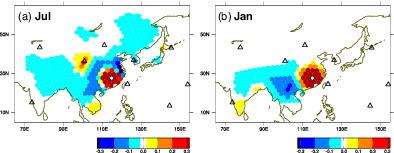当前位置:
X-MOL 学术
›
Q. J. R. Meteorol. Soc.
›
论文详情
Our official English website, www.x-mol.net, welcomes your feedback! (Note: you will need to create a separate account there.)
A conjugate BFGS method for accurate estimation of a posterior error covariance matrix in a linear inverse problem
Quarterly Journal of the Royal Meteorological Society ( IF 8.9 ) Pub Date : 2020-05-27 , DOI: 10.1002/qj.3838 Yosuke Niwa 1, 2 , Yosuke Fujii 2, 3
Quarterly Journal of the Royal Meteorological Society ( IF 8.9 ) Pub Date : 2020-05-27 , DOI: 10.1002/qj.3838 Yosuke Niwa 1, 2 , Yosuke Fujii 2, 3
Affiliation

|
One effective data assimilation/inversion method is the four‐dimensional variational method (4D‐Var). However, it is a non‐trivial task for a conventional 4D‐Var to estimate a posterior error covariance matrix. This study proposes a method to estimate a posterior error covariance matrix applied to the linear inverse problem of an atmospheric constituent. The method was constructed within a 4D‐Var framework using a quasi‐Newton method with the Broyden–Fletcher–Goldfarb–Shanno (BFGS) algorithm. The proposed method was constructed such that conjugacy among the set of increment vector pairs was ensured. It is theoretically demonstrated that, when this conjugate property is coupled with preconditioning, an analytical solution of a posterior error covariance matrix could be obtained from the same number of vector pairs as observations. Furthermore, to accelerate the speed of convergence, the method can be coupled with an ensemble approach. By performing a simple advection test, it was confirmed that the proposed method could obtain an analytical matrix of the posterior error covariance within the same number of iterations as the observations. Furthermore, the method was also evaluated using an atmospheric CO2 inverse problem, which demonstrated its practical utility. The evaluation revealed that the proposed method could provide accurate estimates not only of the diagonal but also of the off‐diagonal elements of the posterior error covariance matrix. Although far more expensive than optimal state estimation, the computational efficiency was found to be reasonable for practical use, especially in conjunction with an ensemble approach. The accurate estimation of a posterior error covariance matrix resulting from the proposed method could provide valuable quantitative information regarding the uncertainties of estimated variables as well as the observational impacts, which would be beneficial for designing observation networks. Furthermore, error correlations derived from the estimated off‐diagonal elements could benefit the interpretation of optimised parameter variations.
中文翻译:

线性逆问题中后误差协方差矩阵的准确估计的共轭BFGS方法
一种有效的数据同化/反演方法是四维变分方法(4D-Var)。但是,对于常规的4D-Var估计后验误差协方差矩阵,这是一项艰巨的任务。这项研究提出了一种方法,用于估计应用于大气成分线性反问题的后误差协方差矩阵。该方法是使用Broyden-Fletcher-Goldfarb-Shanno(BFGS)算法使用准牛顿法在4D-Var框架内构建的。构造提出的方法,以确保增量向量对集合之间的共轭。理论上证明,当此共轭特性与预处理结合时,可以从与观察值相同的向量对中获得后误差协方差矩阵的解析解。此外,为了加快收敛速度,该方法可以与整体方法结合使用。通过执行简单的对流测试,可以确认所提出的方法可以在与观测值相同的迭代次数内获得后验误差协方差的解析矩阵。此外,还使用大气CO评估了该方法2反问题,证明了其实际实用性。评估显示,该方法不仅可以提供对后误差协方差矩阵的对角线元素的精确估计,而且还可以提供非对角线元素的精确估计。尽管比最佳状态估计要贵得多,但是发现计算效率对于实际使用是合理的,尤其是与集成方法结合使用时。由所提出的方法得到的后误差协方差矩阵的准确估计可以提供有关估计变量的不确定性以及观测影响的有价值的定量信息,这对设计观测网络将是有益的。此外,
更新日期:2020-05-27
中文翻译:

线性逆问题中后误差协方差矩阵的准确估计的共轭BFGS方法
一种有效的数据同化/反演方法是四维变分方法(4D-Var)。但是,对于常规的4D-Var估计后验误差协方差矩阵,这是一项艰巨的任务。这项研究提出了一种方法,用于估计应用于大气成分线性反问题的后误差协方差矩阵。该方法是使用Broyden-Fletcher-Goldfarb-Shanno(BFGS)算法使用准牛顿法在4D-Var框架内构建的。构造提出的方法,以确保增量向量对集合之间的共轭。理论上证明,当此共轭特性与预处理结合时,可以从与观察值相同的向量对中获得后误差协方差矩阵的解析解。此外,为了加快收敛速度,该方法可以与整体方法结合使用。通过执行简单的对流测试,可以确认所提出的方法可以在与观测值相同的迭代次数内获得后验误差协方差的解析矩阵。此外,还使用大气CO评估了该方法2反问题,证明了其实际实用性。评估显示,该方法不仅可以提供对后误差协方差矩阵的对角线元素的精确估计,而且还可以提供非对角线元素的精确估计。尽管比最佳状态估计要贵得多,但是发现计算效率对于实际使用是合理的,尤其是与集成方法结合使用时。由所提出的方法得到的后误差协方差矩阵的准确估计可以提供有关估计变量的不确定性以及观测影响的有价值的定量信息,这对设计观测网络将是有益的。此外,



























 京公网安备 11010802027423号
京公网安备 11010802027423号